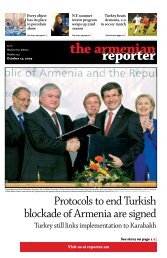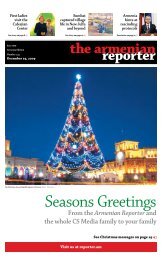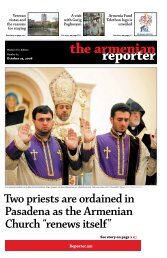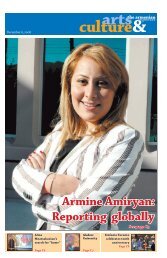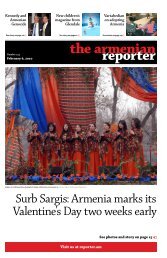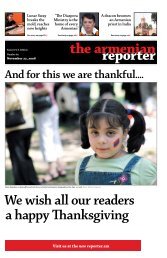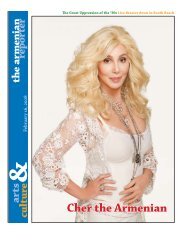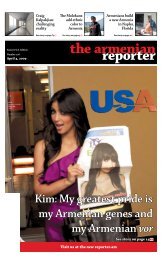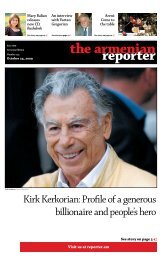Leading lady Karen Kondazian - Armenian Reporter
Leading lady Karen Kondazian - Armenian Reporter
Leading lady Karen Kondazian - Armenian Reporter
You also want an ePaper? Increase the reach of your titles
YUMPU automatically turns print PDFs into web optimized ePapers that Google loves.
the start with the sensuous flesh<br />
of the women and infants, nor<br />
the transcendence of the ending.<br />
In short it lacks the narrative elements<br />
that define the work.<br />
Zara Makatsian, the curator and<br />
truly knowledgeable manager of<br />
the museum, stated that Marcos<br />
Grigorian was planning to have a<br />
special showing of the entire work<br />
this year and was making plans<br />
on how they could find the necessary<br />
space for it. That would have<br />
been an event, for it would have<br />
brought back the last and defining<br />
section of the painting: the rebirth,<br />
the redemption.<br />
To achieve his concept of the<br />
rebirth, Marcos took to heart the<br />
solemn words “earth to earth,<br />
ashes to ashes,” and in one of the<br />
most powerful of his Earthworks,<br />
using earth and ashes, he created<br />
his paean to death and resurrection,<br />
an earthwork sculpture depicting<br />
an eternal earth that even<br />
in days of sorrow and mourning is<br />
heavily pregnant with new birth,<br />
and with it revived hope. It is the<br />
13th panel, and it is left to the<br />
viewer to come away with his or<br />
her own message.<br />
The best of Grigorian’s Earthworks,<br />
and there are several major<br />
pieces in this museum, speak to<br />
me in Biblical terms. Here is the<br />
earth upon the Fall of Man. It is<br />
barren and parched. To recreate<br />
the Garden seems almost hopeless.<br />
Yet, there is no other choice<br />
but unforgiven death. It is an<br />
earth that may bear the fruits of<br />
the garden, but only by husbandry<br />
and unremitting labor irrigated by<br />
sweat and tears. Even then, life on<br />
this earth is a precious miracle.<br />
Add to the Earthworks the introduction<br />
of found objects and<br />
collage, and they take on additional<br />
dimensions. A soil sifter adds a<br />
felicitous circle to one sculpture,<br />
as does a labor-worn plough to<br />
another.<br />
Of the Earthworks on display,<br />
among the most significant is the<br />
one Grigorian proposed as the<br />
eternal symbol of Armenia. It has<br />
Marcos Grigorian’s iconic symbol of Armenia. Like Christendom’s medieval maps where the earth can be<br />
depicted as a circle in a rectangle within which the cross marks the regions, he creates an Earthwork that is<br />
even more elemental. It may be seen as the earth earned by the tragedy of all life lived and by unremitting<br />
labor where survival is not assured but a kind of miracle in recognition of which we must work even harder<br />
to nourish and sustain the future of our offspring.<br />
a resemblance to the ancient, medieval<br />
maps where the earth is a<br />
flat circle in a rectangle, and within<br />
this circle is the cross. It also<br />
has that quality of the pristine<br />
earth ripped out of the Garden after<br />
the Fall where Man again and<br />
again in difficult and unremitting<br />
labor must start over, hoping this<br />
time he will do it right.<br />
Is there a better eternal symbol<br />
of Armenia?<br />
Sun Ladies<br />
The rest of the exhibition includes<br />
his carpets as wall hangings, and a<br />
live weaver at work on the last of<br />
his designs.<br />
Then follows his collection of disparate<br />
items that are in the realm<br />
of precious personal belongings.<br />
This forms the promising beginnings<br />
of a museum that has cohesion<br />
as the designated Near East<br />
Museum only because it is part of<br />
same personal collection, but otherwise<br />
runs from ancient arrowheads<br />
to quaint Singer sewing machines<br />
straight from the factory<br />
100 years ago that grandma used<br />
when wedding dresses were sewn<br />
at home. In this space you may<br />
find some remarkable items but<br />
they will have only the tenuous relationship<br />
to the work in the other<br />
room that you may find at Yerevan’s<br />
Parajanov Museum, where<br />
personal belongings suggest the<br />
<strong>Armenian</strong> <strong>Reporter</strong> Arts & Culture 10/20/2007<br />
C9



